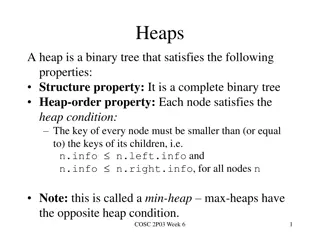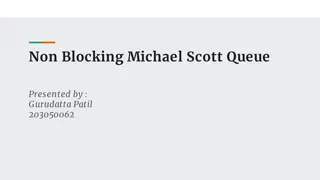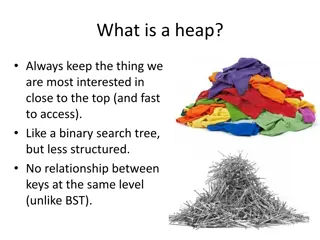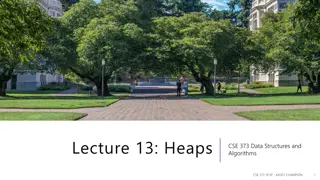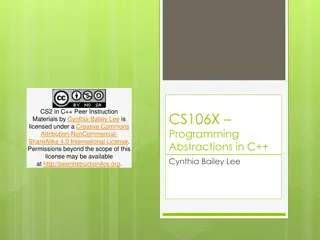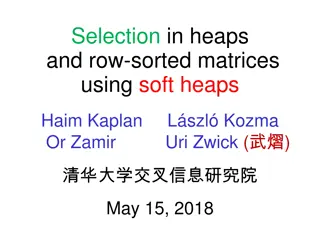Understanding Binary Heaps: Efficient Data Structure for Priority Queue Operations
Explore the concept of binary heaps, a specialized type of binary tree that allows for quick retrieval of the smallest (or largest) element. Learn how binary heaps excel in finding the minimum value, essential for priority queue applications in operating systems, event simulations, and more. Compare binary heaps with other data structures like lists, binary search trees, and hash tables to understand their advantages in terms of speed and flexibility. Discover how binary heaps maintain the heap order property and provide efficient solutions for priority queue operations.
Download Presentation

Please find below an Image/Link to download the presentation.
The content on the website is provided AS IS for your information and personal use only. It may not be sold, licensed, or shared on other websites without obtaining consent from the author. Download presentation by click this link. If you encounter any issues during the download, it is possible that the publisher has removed the file from their server.
E N D
Presentation Transcript
Binary Heaps COL 106 Shweta Agrawal and Amit Kumar
Revisiting FindMin Application: Find the smallest ( or highest priority) item quickly Operating system needs to schedule jobs according to priority instead of FIFO Event simulation (bank customers arriving and departing, ordered according to when the event happened) Find student with highest grade, employee with highest salary etc. 2
Priority Queue ADT Priority Queue can efficiently do: FindMin (and DeleteMin) Insert What if we use Lists: If sorted, what is the run time for Insert and FindMin? Unsorted? Binary Search Trees: What is the run time for Insert and FindMin? Hash Tables: What is the run time for Insert and FindMin? 3
Less flexibility More speed Lists If sorted: FindMin is O(1) but Insert is O(N) If not sorted: Insert is O(1) but FindMin is O(N) Balanced Binary Search Trees (BSTs) Insert is O(log N) and FindMin is O(log N) Hash Tables Insert O(1) but no hope for FindMin BSTs look good but BSTs are efficient for all Finds, not just FindMin We only need FindMin 4
Better than a speeding BST We can do better than Balanced Binary Search Trees? Very limited requirements: Insert, FindMin, DeleteMin. The goals are: FindMin is O(1) Insert is O(log N) DeleteMin is O(log N) 5
Binary Heaps A binary heap is a binary tree (NOT a BST) that is: Complete: the tree is completely filled except possibly the bottom level, which is filled from left to right Satisfies the heap order property every node is less than or equal to its children or every node is greater than or equal to its children The root node is always the smallest node or the largest, depending on the heap order 6
Heap order property A heap provides limited ordering information Each path is sorted, but the subtrees are not sorted relative to each other A binary heap is NOT a binary search tree -1 2 1 1 0 6 4 6 2 0 7 5 8 4 7 These are all valid binary heaps (minimum) 7
Binary Heap vs Binary Search Tree Binary Heap Binary Search Tree min value 5 94 10 94 10 97 min value 97 24 5 24 Parent is less than both left and right children Parent is greater than left child, less than right child 8
Structure property A binary heap is a complete tree All nodes are in use except for possibly the right end of the bottom row 9
Examples 6 2 4 2 4 6 complete tree, heap order is "max" 5 not complete 2 2 4 6 5 6 7 5 7 4 complete tree, heap order is "min" complete tree, but min heap order is broken 10
Array Implementation of Heaps (Implicit Pointers) Root node = A[1] Children of A[i] = A[2i], A[2i + 1] Parent of A[j] = A[j/2] Keep track of current size N (number of nodes) 1 2 2 3 4 6 - 2 4 6 7 5 value index 0 1 2 3 4 5 6 7 7 5 4 5 N = 5 11
FindMin and DeleteMin FindMin: Easy! Return root value A[1] Run time = ? 2 4 3 7 5 8 10 11 9 6 14 DeleteMin: Delete (and return) value at root node 12
DeleteMin Delete (and return) value at root node 4 3 7 5 8 10 11 9 6 14 13
Maintain the Structure Property We now have a Hole at the root Need to fill the hole with another value When we get done, the tree will have one less node and must still be complete 4 3 7 5 8 10 11 9 6 14 4 3 7 5 8 10 11 9 6 14 14
Maintain the Heap Property The last value has lost its node we need to find a new place for it 14 4 3 7 5 8 10 11 9 6 15
DeleteMin: Percolate Down 14 ? 14 3 3 ? 4 8 4 3 4 7 5 14 10 7 5 8 10 7 5 8 10 11 9 6 11 9 6 11 9 6 Keep comparing with children A[2i] and A[2i + 1] Copy smaller child up and go down one level Done if both children are item or reached a leaf node What is the run time? 16
1 2 3 4 5 6 6 | 10 | 8 | 13 | 14 | 25 Percolate Down PercDown(i:integer, x: integer): { // N is the number elements, i is the hole, x is the value to insert Case{ 2i > N : A[i] := x; //at bottom// 2i = N : if A[2i] < x then A[i] := A[2i]; A[2i] := x; else A[i] := x; 2i < N : if A[2i] < A[2i+1] then j := 2i; else j := 2i+1; if A[j] < x then A[i] := A[j]; PercDown(j,x); else A[i] := x; }} no children one child at the end 2 children 12/26/03 Binary Heaps - Lecture 11 17
DeleteMin: Run Time Analysis Run time is O(depth of heap) A heap is a complete binary tree Depth of a complete binary tree of N nodes? depth = log2(N) Run time of DeleteMin is O(log N) 18
Insert Add a value to the tree Structure and heap order properties must still be correct when we are done 2 3 4 8 7 5 14 10 11 9 6 19
Maintain the Structure Property The only valid place for a new node in a complete tree is at the end of the array We need to decide on the correct value for the new node, and adjust the heap accordingly 2 3 4 8 7 5 14 10 11 9 6 20
Maintain the Heap Property The new value goes where? 3 4 8 7 5 14 10 11 9 6 2 21
Insert: Percolate Up 2 3 ? 3 3 4 8 4 8 8 7 5 14 10 7 14 10 7 4 14 10 ? ? 11 9 6 11 9 6 11 9 6 5 5 2 2 Start at last node and keep comparing with parent A[i/2] If parent larger, copy parent down and go up one level Done if parent item or reached top node A[1] 22
Insert: Done 2 3 8 7 4 14 10 11 9 6 5 Run time? 23
Binary Heap Analysis Space needed for heap of N nodes: O(MaxN) An array of size MaxN, plus a variable to store the size N Time FindMin: O(1) DeleteMin and Insert: O(log N) BuildHeap from N inputs ??? 12/26/03 Binary Heaps - Lecture 11 24
Build Heap BuildHeap { for i = N/2 to 1 PercDown(i, A[i]) } 1 N=11 11 11 2 3 5 10 5 10 4 5 6 7 9 4 8 12 9 3 8 12 2 7 6 3 2 7 6 4 8 11 9 10 12/26/03 Binary Heaps - Lecture 11 25
Build Heap 11 11 5 10 5 8 2 3 8 9 2 3 10 12 9 7 6 4 9 7 6 4 12/26/03 Binary Heaps - Lecture 11 26
Build Heap 11 2 2 8 3 8 5 3 10 12 5 4 10 12 9 7 6 4 9 7 6 11 12/26/03 Binary Heaps - Lecture 11 27
Time Complexity Na ve considerations: n/2 calls to PercDown, each takes clog)n) Total:?? ??? ? More careful considerations: Only O(n)
Analysis of Build Heap Assume n = 2h+1 1 where h is height of the tree Thus, level h has 2h nodes but there is nothing to PercDown At level h-1 there are 2h-1 nodes, each might percolate down 1 level At level h-j, there are 2h j nodes, each might percolate down j levels Total Time = O(n) 12/26/03 Binary Heaps - Lecture 11 29
Other Heap Operations Find(X, H): Find the element X in heap H of N elements What is the running time? O(N) FindMax(H): Find the maximum element in H Where FindMin is O(1) What is the running time? O(N) We sacrificed performance of these operations in order to get O(1) performance for FindMin 12/26/03 Binary Heaps - Lecture 11 31
Other Heap Operations DecreaseKey(P, ,H): Decrease the key value of node at position P by a positive amount , e.g., to increase priority First, subtract from current value at P Heap order property may be violated so percolate up to fix Running Time: O(log N) 12/26/03 Binary Heaps - Lecture 11 32
Other Heap Operations IncreaseKey(P, ,H): Increase the key value of node at position P by a positive amount , e.g., to decrease priority First, add to current value at P Heap order property may be violated so percolate down to fix Running Time: O(log N) 12/26/03 Binary Heaps - Lecture 11 33
Other Heap Operations Delete(P,H): E.g. Delete a job waiting in queue that has been preemptively terminated by user Use DecreaseKey(P, ,H) followed by DeleteMin Running Time: O(log N) 12/26/03 Binary Heaps - Lecture 11 34
Other Heap Operations Merge(H1,H2): Merge two heaps H1 and H2 of size O(N). H1 and H2 are stored in two arrays. Can do O(N) Insert operations: O(N log N) time Better: Copy H2 at the end of H1 and use BuildHeap. Running Time: O(N) 12/26/03 Binary Heaps - Lecture 11 35



